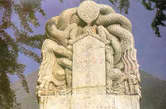 At the foot of Mount Sanpen in Zhoukoudian in southwestern Beijing lie the ruins of a church named the Monastery of the Cross the only remaining church belonging to the Jing sect of Christianity in China. At the foot of Mount Sanpen in Zhoukoudian in southwestern Beijing lie the ruins of a church named the Monastery of the Cross the only remaining church belonging to the Jing sect of Christianity in China.
Apart from the foundations of the church, there remain a jingo tree, two stone tablets and the Saint-Worship Church tablet erected in the Liao Dynasty (916-1125) and the Monastery of the Cross tablet set up during the Yuan Dynasty (1271-1368) and a stone carving of a cross with Syriac writing. With the passage of time, everything has gone except the blurred writings on the tablets that are telling us the thousand-year history of the old church.
At the end of the Jin Dynasty (1115-1234) and the beginning of the Yuan Dynasty, different religions such as Taoism, Christianity, Islamism and Shaman flourished in the Beijing area in addition to Buddhism.
Jingjiao or the Jing sect, the Chinese name for Nestorian sect of the Christian Church, entered China during the Tang Dynasty (618-907). It started in the year 635 when Bishop Olopen of the Nestorian sect arrived in the Tang capital Chang'an and Emperor Tai Zong issued the edict to construct a church for him. Nestorianism thrived once again especially in Northwest China during the Yuan Dynasty and the Yuan capital Dadu became an arch-diocese, with an European archbishop living in Cambaluc (i.e. Beijing).
There were Christian churches in Dadu with a congregation of several dozen thousands and the government set up a special office to administer religious affairs. A considerable number of the members of the Imperial family as well as the nobility were believers and followers of Jingjiao, and Din Zong Guruk Khan as well as Kublai Khan' mother were both pious adherents. Later on, with the introduction and spread of Roman Catholicism and Islamism in China, Jingjiao declined and finally disappeared at the end of the Yuan Dynasty.
Rabban Saumal
 Rabban Saumal was born around 1230-1234 in a Uygur family believing in Jingjiao and his father, a devoted believer, served as an inspector of Jingjiao. Under the influence of his family, he became a Jingjiao believer during his teenage years, and was accepted as a seminarian at the age of 30 by Archbishop Georgius. After 6 years as a seminarian he went to the Monastery of the Cross at Fangshan, outskirts of Beijing, and spent a period of time there as a friar. For the sake of his belief, he and Friar Marcus decided to go to Syria to pay homage to the chief of the Nestorian Church and the Holy Land. Rabban Saumal was born around 1230-1234 in a Uygur family believing in Jingjiao and his father, a devoted believer, served as an inspector of Jingjiao. Under the influence of his family, he became a Jingjiao believer during his teenage years, and was accepted as a seminarian at the age of 30 by Archbishop Georgius. After 6 years as a seminarian he went to the Monastery of the Cross at Fangshan, outskirts of Beijing, and spent a period of time there as a friar. For the sake of his belief, he and Friar Marcus decided to go to Syria to pay homage to the chief of the Nestorian Church and the Holy Land.
They left the monastery in 1276 and started their westbound journey along the Silk Road. They traveled through the Hexi Corridor, reached the Yangguan and Yumenguan passes in Northwest Chin' Gansu Province and then pressed forward for two months along the southern edge of the Taklimakan Desert, i.e., the southern route of the Silk Road and reached Hotan, overcoming various life-threatening hardships. After a 6-month rest and refreshing, they arrived in Kashgarswheresthey left China and proceeded towards Europe.
They reached Naples, Italy in 1287, traversing the whole course to China covered by Marco Polo in an opposite way. They then went to Baghdad and stayed there, never returning to China. Their only regret was that they were never able to fulfill their wish to make a pilgrimage to Jerusalem.
War broke out once again between Britain and France when Rabba Saumal, lying on his deathbed, heard the deep and distant prayers. He died in Persia in 1294.
The Silk Road, an ancient trading road leading to Europe opened some 2000 years ago by Zhang Qian of the Han Dynasty (206B.C.-A.D.220) exerted great influence on the exchanges between the Chinese and other countries'cultures. The most outstanding case was the introduction of Buddhism \into\ China from India. Christianity entered China by the same route.
Traveling through Persia and Pakistan and reaching China' western region via the eastern section of this road, the Italian merchant Marco Polo, together with his uncle, arrived in the Yuan capital Dadu and became an official in the Yuan Court, spending nearly 17 years in Asia. After their return to Italy in 1295, a book entitled Travels of Marco Polo helped European people' understanding of China.
At the time when Marco Polo reached China, Rabban Saumal left the Yuan capital Dadu and started his journey to Europe along the Silk Road. His manuscripts Chronicles of Europe written in Syriac was discovered in Persia in1887. The significance of his journey lies in the fact that he made his trip from China to Europe, and most likely he was the first Eastern Asian traveler who visited Europe. Marco Polo' arrival in China from Europe coincided with Rabban Saumal' departure from China to Europe, and this marked a very dramatic beginning of Sino-European communication. Both of them have made indelible contributions to China' contacts with other countries.
| 
![]() 本网站由北京信息港提供网络支持
本网站由北京信息港提供网络支持

![]() 本网站由北京信息港提供网络支持
本网站由北京信息港提供网络支持